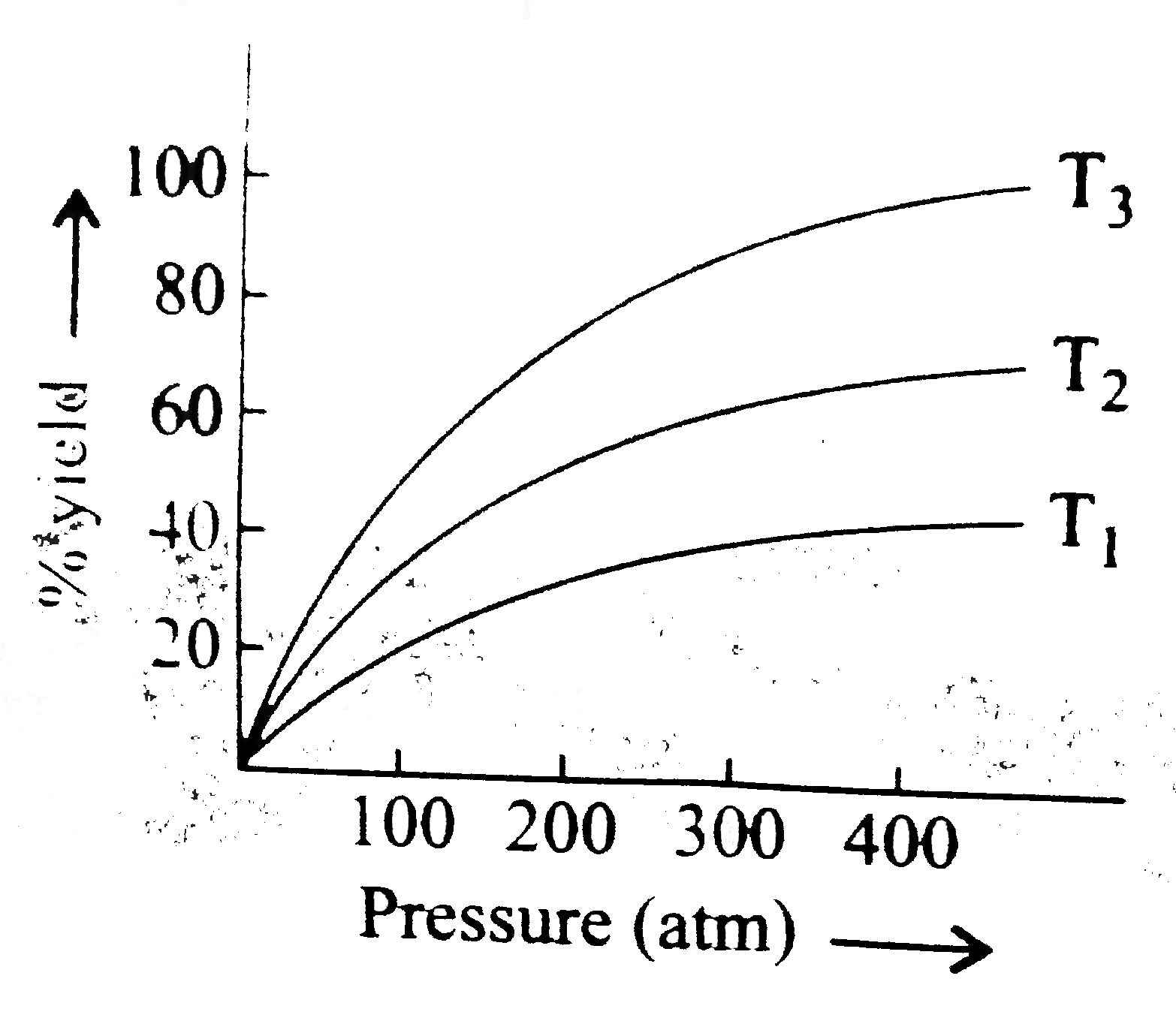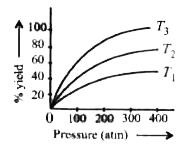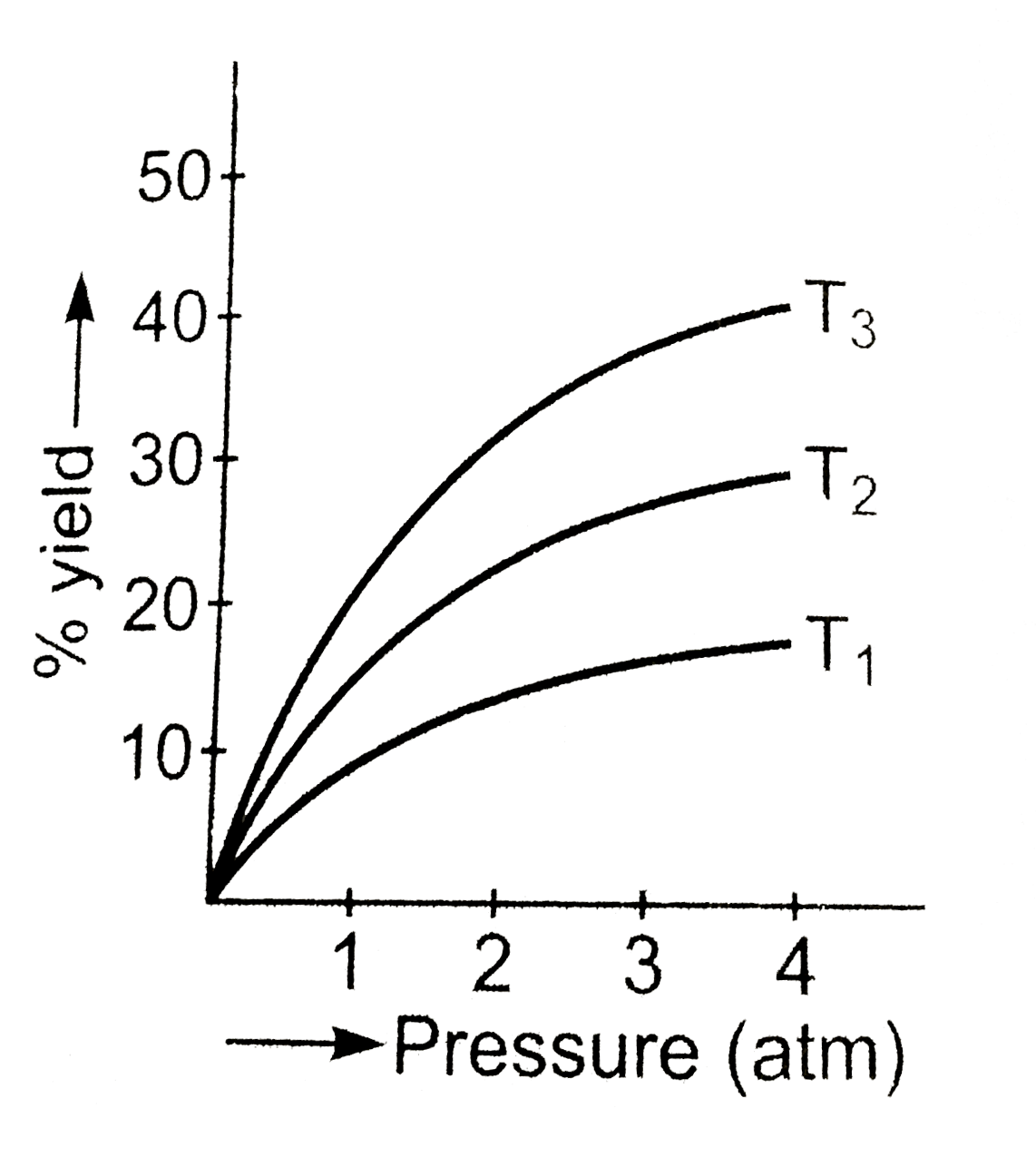Ammonia is manufactured according to the following reaction
N2(g)+3H2(g)<⇒2NH3(g),ΔH=−22.4kJ
During preparation the pressure and temperature are maintained at 200 atm and 500∘C respectively inside the chamber. The reaction is carried out in presence of Fe catalyst and known as Haber's process.
For the given reaction, yields of ammonia at temperature T1,T2 and T3 are found to be 40%,60%and80%. Then for temperature T1,T2andT3 the correct option is
T3>T2>T1
T1>T2>T3
T1=T2=T3
nothing could be predicted.
The correct Answer is:B
For exothermic reaction as temperature decreases reaction proceeds in forward direction, so greater yield of ammonia produced at lower temperature. So, T1>T2>T3.
Topper's Solved these Questions
- CHEMICAL EQUILIBRIUMBOOK - MTG IIT JEE FOUNDATIONCHAPTER - CHEMICAL EQUILIBRIUMEXERCISE - EXERCISE (INTEGER/NUMERICAL VALUE TYPE)
5 Videos
- CHEMICAL EQUILIBRIUMBOOK - MTG IIT JEE FOUNDATIONCHAPTER - CHEMICAL EQUILIBRIUMEXERCISE - EXERCISE (ASSERTION & REASON TYPE)
10 Videos
- CHEMICAL BONDING BOOK - MTG IIT JEE FOUNDATIONCHAPTER - CHEMICAL BONDING EXERCISE - Exercise (Integer/Numerical Value Type )
5 Videos
- CHEMICAL REACTIONS AND EQUATIONSBOOK - MTG IIT JEE FOUNDATIONCHAPTER - CHEMICAL REACTIONS AND EQUATIONSEXERCISE - OLYMPIAD/HOTS CORNER
20 Videos
Similar Questions
N2(g)+3H2(g)⇔2NH3(g),ΔHɵ=−22.4kJ
The pressure inside the chamber is 100 atm and temperature at 300K
The preparation of ammonia by Haber's process is an exothermic reaction. If the preparation follows the following temperature-pressure relationship for its % yield. Then for temperature T1,T2 and T3 the correct option is:

View SolutionFor the reaction at 127∘ C
N2(g)+3H2(g)⇔2NH3(g)
the partial pressures of N2 and H2 are 0.80 and 0.40 atm respectively at equilibrium. The total pressure of the system is 2.80 atm. Calculate Kp and Kc for the reaction.
View Solution
Knowledge Check
Ammonia is manufactured according to the following reaction
N2(g)+3H2(g)<⇒2NH3(g),ΔH=−22.4kJ
During preparation the pressure and temperature are maintained at 200 atm and 500∘C respectively inside the chamber. The reaction is carried out in presence of Fe catalyst and known as Haber's process.
If Kc for the reaction is 594.75molL−1, then the value of Kp will beA5.94×10−5B2.42×10−3C1.47×10−1D1.47×10−3Ammonia is manufactured according to the following reaction
N2(g)+3H2(g)<⇒2NH3(g),ΔH=−22.4kJ
During preparation the pressure and temperature are maintained at 200 atm and 500∘C respectively inside the chamber. The reaction is carried out in presence of Fe catalyst and known as Haber's process.
If Kc for the reaction is 594.75molL−1, then the value of Kc for the decomposition of NH3,
2NH3(g)<⇒N2(g)+3H2(g)will beA√594.75B(594.75)2C1/594.75D1/(594.75)2The preparation of ammonia by Haber's process is an exothermic reaction. If the process follows the following temperature pressure relationship for its % yield, then for temperatures T1,T2,andT3 the correct option is
 AT3>T2>T1BT1>T2>T3CT1=T2=T3Dnothing could be predicted.
AT3>T2>T1BT1>T2>T3CT1=T2=T3Dnothing could be predicted.
The prepation of SO3(g) by reaction SO2(g)+12O2(g)⇔SO3(g) is an exothermic reaction .If the preparation follows the following temperature -pressure relationship for % yield , then for temperatures T1,T2andT3 the correct option is:

View SolutionState the -i] Temperature ii]Catalyst used in the Haber 's process for manufacture of ammonia. Give the equation for the catalyzed reaction.
View SolutionN2(g)+3H2(g)⇔2NH3(g),ΔHɵ=−22.4kJ
The pressure inside the chamber is 100 atm and temperature at 300K
The preparation of ammonia by Haber's process is an exothermic reaction. If the preparation follows the following temperature-pressure relationship for its % yield. Then for temperature T1,T2 and T3 the correct option is:

View SolutionThe prepation of SO3(g) by reaction SO2(g)+12O2(g)⇔SO3(g) is an exothermic reaction .If the preparation follows the following temperature -pressure relationship for % yield , then for temperatures T1,T2andT3 the correct option is:

View SolutionIn the Haber process N2+3H2⇔2NH3 pressure is about 200 atm in pressure of catalyst and temperature is kept 500∘C even though the reaction is exothermic.
Reason : Energy needed for this reaction is easily obtained at this temperature.
View Solution
